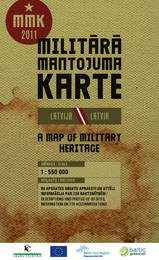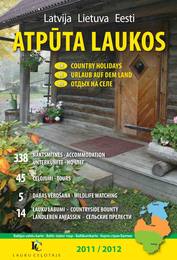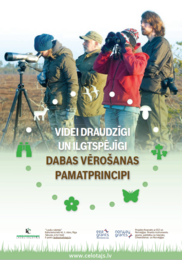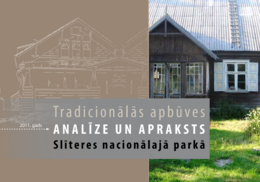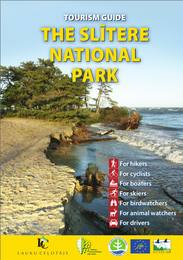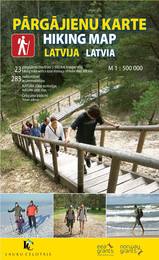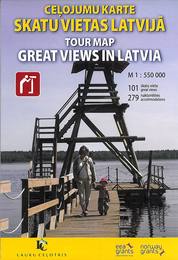Reiseliteratur
Von "Lauku ceļotājs"Um die Publikationen zu bestellen, schreiben Sie bitte eine E-mail an lauku@celotajs.lv. Sie können mit Kreditkarte oder per Banküberweisung zahlen. |
| Publication | Description |
|---|---|
A Guide to the Coast of the Baltic Sea. LatviaThis is a guide along the Baltic Sea coast of Latvia. If you are planning your holidays by the sea then this publication will help you to choose a place for overnight stay as well as some ideas on what to do. The coastline stretches for 500km and you can experience a great variety of landscape from splendid sandy beaches to rocky shores and steep banks. Seaside resorts near Rīga and Jūrmala are full of life but out in the countryside there are quiet fishing villages and secluded areas for those enjoying privacy and nature. You will find here reviews for:
|
|
Baltic National Parks - Estonia, Latvia, LituaniaThis guidebook offers practical advice and infor- mation which you can take along on your travels. It is meant for people who are interested in the environ- ment and various cultural and historical monuments. It is also intended for active tourists who like hiking, bi- king, boating or cross-country skiing. Public transpor- tation services will not always deliver you to the de- sired locations quickly and conveniently, so we have also given though to those readers who drive their own cars. The guide covers the most important information about all of the national parks in the Baltic States (14 in all), along with their most important environmental, cultural and historical values, as well as their most in- teresting points of interest. The authors have attached a map of each national park, along with GPS co-ordi- nates for the most interesting destinations. There are several informational sections about each park: Information can become out of date very quickly, and many things can change, so before you set off on your trip, we suggest that you should contact the visi- tor or tourism information centre of the relevant park. The author of this guidebook has personally visited all of the national parks and the destinations cited therein, doing so on a regular basis over the past 20 years. All of the routes which are listed have been examined and checked out. |
|
National Parks of Latvia (English version)This guidebook is meant to offer practical advice and information. Please bring it along with you when travelling. We have written the book for people who like to observe wild nature, learn about various cultural and historical monuments, or be active tourists who will visit national parks on foot, on a bike, by boat or on skis. We have not forgotten about those of you who want to drive a car, either. The guidebook offers information about the most important environmental, cultural and historical values of Latvia’s four national parks, also listing the most interesting tourist destinations. Maps are included, and GPS co-ordinates are offered for the most interesting objects so as to make it easier for you to find your way around the parks. This guidebook is written under the project „Parks&Benefits” (No. 21), EU Interreg IVB Baltic Sea Region program, and promotes implementation of the European Charter for Sustainable tourism in protected areas www.european-charter.org.
|
|
NATIONAL PARKS IN LATVIA (Latvian version)This guidebook is meant to offer practical advice and information. Please bring it along with you when travelling. We have written the book for people who like to observe wild nature, learn about various cultural and historical monuments, or be active tourists who will visit national parks on foot, on a bicycle, by boat or on skis. We have not forgotten about those of you who want to drive a car, either. The guidebook offers information about the most important environmental, cultural and historical values of Latvia’s four national parks, also listing the most interesting tourist destinations. Maps are included, and GPS co-ordinates are offered for the most interesting objects so as to make it easier for you to find your way around the parks. Information can quickly become out of date, of course, so before you start off, make sure that you contact the local tourism information centre to find out the necessary information. The author of the guidebook has visited all of the destinations that are listed here, and all of the routes have been examined in situ. This guidebook is written under the project „Parks&Benefits” (No. 21), EU Interreg IVB Baltic Sea Region program, and promotes implementation of the European Charter for Sustainable tourism in protected areas www.european-charter.org. |
|
Map of Military HeritageThis map of Latvia’s military heritage is aimed not just at inviting people to go on a unique trip to learn about Lat- via’s military history, but also at offering a single source of information about little known, but very interesting objects about which we have very little evidence. Military heritage in terms of this map refers to histor- ical outdoor objects such as redoubts, fortresses, certain castles, shoreline defence batteries, bunkers, dugouts, locations of major battles, former military bases, army airfields and bases, as well as museums and collections located in places where history can be studied close up. The map mostly covers military objects from the last few centuries – objects which are related to different military forces and the things that they did. Many of the destinations are well-appointed, and everal have available guides. There are a few destina- ons which are accessible only in accordance with spe- fic rules. Others are not well-appointed or are closed o visitors. In the latter case (the army base at Skrunda, or instance), it is worth visiting the destinations anyway o as to place them on the list of military heritage objects hat you have seen. This map includes descriptions of 60 military objects, complete with photographs, including histori- al ones. There is also information about 239 places which offer accommodations. Many of the objects re in NATURA 2000 territories, and some are cultural monuments. |
|
Atpūta laukos 2011-2012The countryside accommodation catalogue "Country holidays 2011-2012" contains information on 338 accomodation properties in Latvia, Lithuania, Estonia, open farms, 45 touring routes in national parks and other nature areas, sites and services for bird, animal, insect, mushroom and plant watching activities. Printed copies can be ordered from the office of "Lauku ceļotājs". The catalogue is also available in the largest book stores in Latvia.
|
|
Nature HolidaysThe “Weekends Out in the Countryside” map is meant to ofer practical advice about places to go, how to get there, and what you can see once you arrive. It is meant for bird, animal and plant watchers, as well as for those who love active leisure – hiking, biking, boating and crosscountry skiing. This map includes information about 100 destinations that are of importance at the Baltic level in terms of tourism facilities. These are wellappointed environmental territories such as national parks, nature parks, reserves, nature reserves, protected landscapes and interesting objects therein. There are also notable natural monuments such as trees, rocks, clifs, etc. In each territory, we have ofered you our thoughts about the best way to travel there and which routes you should take. Most of the locations are in NATURA 2000 territories, while others are protected environmental monuments or cultural monuments. The map also ofers information about 383 accommodations where you can spend a night or two. |
|
Botanical guide. The Plant FinderThe main goal of the authors of this guide is to help you to spot the types of plants and mushrooms that are all around us. We really want to tell you interesting things about them. “Worth Seeing” is our section on Latvia’s most interesting botany-related nature trails, including information about huge and/or interesting trees of various species, alleys of trees, botanical gardens, dendrology parks, other types of plant collections, museums, interesting farms, etc. You can visit each of them for yourself. We chose destinations in all of Latvia’s historical regions. “Plant and Mushroom Routes” contains a list of ready-made routes, al- though we suggest that you bring along a guide to make sure that you en- joy the route thoroughly. Still, you can take the trips individually, adapt- ing the process to your own interests and capabilities. “Plant Finder” is the biggest and most important part of the guide. There are included the photos of more than 400 different most common plants, lichens and mushrooms species in order to help you to recognize them in the field. Each species has got some interesting facts or stories as far as its possible. “Protect and preserve” is our list of all of the protected species of plants which are often plucked for bouquets and other compositions, often with the person not even realising that he or she has picked a protected plant. These are species which need to be left alone right where they are. This guide can be used as a workbook in your practical observations. Each of the «Worth seeing» objects has a check-box. Mark the sites you have visited. In the «Plant Finder» section, write the date you spotted the plant in the line «When ... », and the name of the place in the line “Where...”. With the contribution of the LIFE financial instrument of the European Communitys under the project POLPROP-NATURA (LIFE07 ENV/LV/000981) |
|
Environmentally friendly and sustainable guiding principles for nature watchingThe purpose of the guidelines is to promote environmentally friendly, sustainable and non-depleting tourism both within and outside nature conservation areas. This edition is intended for rural tourism entrepreneurs, municipal employees, and others who plan to design, offer and promote a nature tourism product using the diversity of the species we are so rich in. The booklet contains essential information on how to observe plants, fungi, beasts, birds, insects, and how to behave in natural areas. Here you will find practical tips for creating and marking active tourism routes in the nature. Also included is an overview map of the 30 most prominent nature sites in Latvia with great potential for a nature watching product. Useful sources of information are also added. |
|
COASTAL BUILDING GUIDELINES. Principles of seacoast construction. Regional peculiarities of construction. Guidelines for New Construction.We all own a beautiful, diverse, almost 500 km long and still unspoiled treasure - the Baltic Sea coast. In order to preserve the coastline and to keep it traditionally tasteful for the benefit of both residents and guests, we, the Baltic Country Holidays, suggested writing these "Coastal Building Guidelines". The guidelines are intended for landowners, residents and businesses, all those involved in the construction process and coastal municipalities who plan and implement coastal construction in harmony with traditional and contemporary values. They describe the general building principles of the Baltic Sea coast of Latvia, briefly describing the regional differences and peculiarities of building in Vidzeme, Northern Kurzeme and Southern Kurzeme in each section of the historical building review. |
|
Analysis and description of traditional buildings in Slītere National ParkAs most of Slītere NP territory was historically inhabited by Livs and in order to preserve Liv cultural and historical territories and to ensure preservation of Liv language traditions and other cultural and historical values, the Council of Ministers of the Republic of Latvia On December 14, 1999 the Cabinet of Ministers of the Republic of Latvia approved the action plan of the state long-term target program “Livs in Latvia”. Within the framework of the plan, S. Cimermanis prepared a list of preserved objects of national construction. Inventory and photo fixation of the volume, details, construction joinery, facade decoration of the villages, fences and buildings in the territory of Slītere NP is based on the aforementioned research by S. Cimerman. The purpose is to give those interested the familiarity with the building traditions of the former Liv villages, to understand the local building style and to use it for the construction of new buildings. |
|
The Slitere National Park Tourism guide
In the Slītere Traveller’s guide you will find: The most significant events and facts on the history of nature and people which are related to the Kurzeme penninsula, the Livonian coast and the Slītere national park; Worth seeing and knowing,– descriptions of more than 100 natural and cultural heritage sites, especially highlighting the 12 treasures of Slītere; Touring itineraries – a variety of routes for walking, cycling, boating, bird and animal watching and driving; Annual events – a calendar with time schedule of the regular events, taking place in the Slītere national park; ”Green” and practical advice for every mode of touring the Slītere national park. Services and facilities – accommodations, food, equipment rentals, banks and other practical information. The map of the Slītere national park. Languages: Latvian, English Price: Free of charge in the office of the Latvian country tourism association.By post upon request, covering the postage costs. With the contribution of the LIFE financial instrument of the European Communitys under the project POLPROP-NATURA (LIFE07 ENV/LV/000981) |
|
Radwanderkarte 2010Diese Radwanderkarte des Baltikums stellt Ihnen in kurzen Beschreibungen 14 verschiedene Radstrecken mit einer Gesamtlänge von über 3.700 km vor. Daneben enthält sie ebenfalls Informationen über mögliche Bootstouren auf Flüssen und der Ostsee, so dass sich für Sie eine völlig neue Perspektive auf die urwüchsige Landschaft eröffnet, und Sie weitere unvergessliche Erfahrungen sammeln können. Die benötigte Ausrüstung kann und sollte bereits im Voraus organisiert werden (siehe Abschnitt „Ihre Reisebuchung”). Darüber hinaus finden Sie in der Karte aktuelle Informationen zu 403 touristischen Unterkünften. Bitte beachten Sie: Baltic Country Holidays hat sämtliche Routen geprüft, aber sowohl die entsprechenden Informationen als auch die allgemeine Situation können sich sehr kurzfristig ändern. Die hier vorgestellten Routen führen durch verschiedene Naturschutz- und NATURA 2000-Gebiete, genauso wie zu geschichtsträchtigen Stätten und Kulturdenkmälern . Und denken Sie immerdaran:Es gibt keinschlechtes Wetter - nur schlechte Kleidung!
|
|
Wanderstreckenkarte in Lettland
In der Wanderstreckenkarte sind 23 Strecken zum Wandern angegeben mit der Gesamtlänge von über 500 km. Die Strecken führen hauptsächlich die Meeresküste, Waldwege oder Ufer von Flusstälern entlang. Der Karte wurden sechs schon bevorzugte Territorien hinzugefügt – eine noch größere Auswahl von Wanderstrecken für verschiedene Geschmäcker. Zusätzlich ist Information über 283 Tourismusunterkünfte auf der Karte angegeben.
|
|
Great Views in LatviaThe new map includes 101 great views' sites in Latvia created by nature or people - viewing towers, hills, riverbanks from where travellers can enjoy the landscapes of Latvia in different seasons. For each site, there is a description, a photo and contact details to book excursions or other services, where provided. Tourist accommodations provided by the Latvian Country Tourism Association are also included. The map is available from the office of "Lauku ceļotājs", and as a free supplement to the catalogue "Country Holidays 2009-2010". The map is produced under the project ""Sustainable use and management of nature resources in the Natura2000 sites - popular and potential tourism destinations in Latvia." |
|




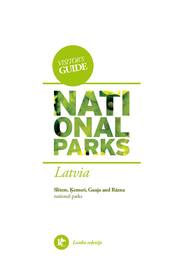




 These projects are partly financed by the European Union (ERDF) within the Baltic Sea Region
These projects are partly financed by the European Union (ERDF) within the Baltic Sea Region 